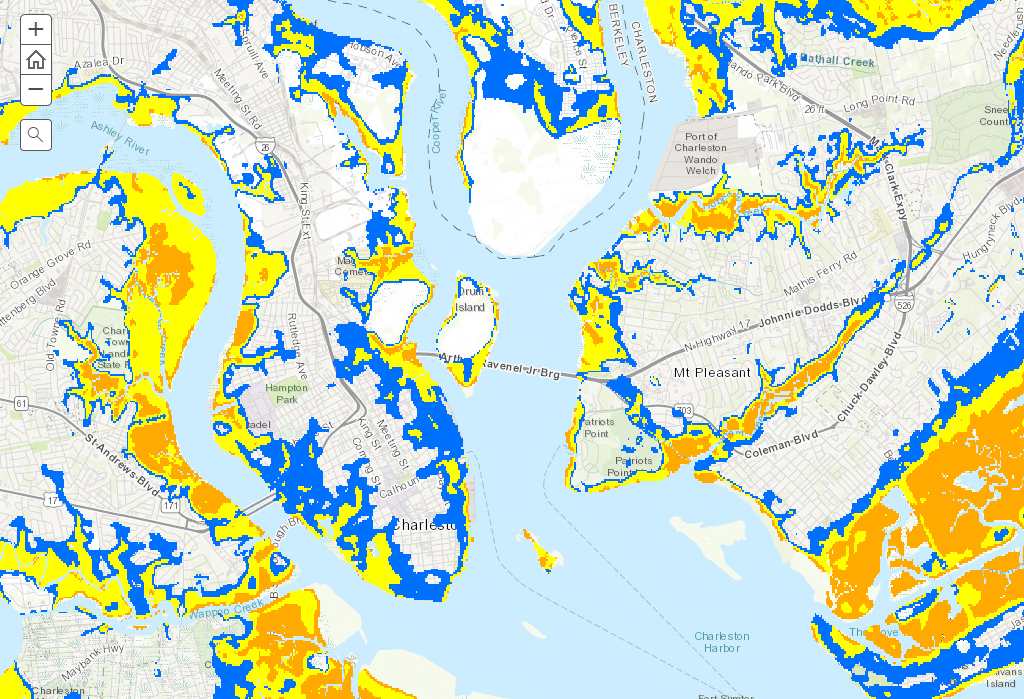Like many coastal areas across the country, the city of Charleston continues to bear the brunt of an increasingly volatile and changing climate. Last year saw a record number of “s day” floods and this year marks the sixth consecutive year where tropical storms have formed before hurricane season has actually begun. The City of Charleston is to be commended for its continued commitment to studying the effects of climate change and implementing projects to not only address current problems but also mitigate future impacts. The Charleston Peninsula Study conducted by the US Army Corps of Engineers represents the latest in a series of studies and offers a thorough analysis of a single issue that threatens the peninsula of Charleston: storm surge. The potential economic and cultural impact of a severe hazard event are well presented and the concept of a barrier (in some form) to address this issue has been discussed previously, including the 2019 Dutch Dialogues report. However, the Peninsula Study’s intentional limitation to this one topic ignores the reality of additional documented hazards that represent a growing economic and environmental threat to our community. As noted in the report materials online, this proposal needs to be considered as part of a comprehensive strategy to address flooding, sea level rise, and the impacts of storm events. However, this analysis does not address these other hazards or offer analysis of how this plan could support or enhance other ongoing infrastructure projects and planning proposals.
Many of the concepts presented in the draft report are still in the early conceptual stage and will require extensive additional study and discussion to truly determine their feasibility and the potential adverse or beneficial impacts. Additional study of the environmental impact of the proposed barrier and the wave attenuation device at the south end of the peninsula should be completed prior to proceeding. The concept of “moveable” pump stations in concert with permanent ones does not appear to have been thoroughly vetted and creates a potential point of failure if pumps are rendered immobile or are not deployed with enough time to be effective. The study’s current focus offers two structural options for a barrier wall, both of which neglect the rich history of Charleston’s relationship with water. While these responses offer an engineered response to the question of storm surge, this problem requires a more integrated design solution that addresses the specific context in which it is located. A combination of “rigid” infrastructure and “soft” landscape solutions could mitigate the impact to cultural and natural resources and offer amenities for residents.
Complex problems like Climate Change and the design of resilient cities are not linear in nature and cannot be treated as an equation to solve. These “Wicked Problems” involve multivariable, interconnected systems that include not only environmental and economic issues, but social impacts as well. Charleston’s rich history of preservation may be best known for its emphasis on the protection of the built environment, but it is the people who live and work in those buildings that define our community. It is the people of our community who actively (and vocally) participate in a robust public discourse that informs stakeholders and civic leaders and collectively shapes the future of our city.
Projects such as The “BIG U”, a post Hurricane Sandy project to create a storm surge barrier along a continuous 10 mile stretch of Lower Manhattan, offer a model for civic engagement and public participation. The design and development team met individually with neighborhoods throughout the study area to understand their concerns and developed contextually appropriate design strategies that address community concerns and provide amenities to maintain and improve their relationship to the water.
The Charleston Peninsula Study represents an important step forward in the City of Charleston’s efforts to address the climate hazards that are facing our community. As the study continues to develop, a comprehensive public engagement strategy and a broader understanding of economic, environmental, and social impacts of this proposal will be necessary to truly judge its success. The Architects of AIA Charleston and the AIA South Carolina Resilience Committee look forward to continuing the conversation and working collaboratively to design a more resilient Charleston.
The AIA South Carolina Resilience Committee promotes a multi-disciplinary, systems-based design approach to addressing social, economic and environmental hurdles to achieving sustainable, resilient, and adaptable communities. The Committee focuses on topics of disaster assistance, hazard mitigation, climate adaptation, and resilience by creating a forum for knowledge sharing and networking among South Carolina Architects.
